With this year’s GKA SuperFoil event less than a week away, we’re flipping the reels into rewind and taking you back to last year’s interview with Fred Hope, fresh after his win at the GKA SuperFoil, the first freestyle foil event of its kind. Our conversation with Fred talks about his transition into foilboarding, his head to head battle with Charles Brodel and the future of competitive freestyle foilboarding.

Preface to our conversation with Fred
Typically, the athletic field is populated with a group of individuals that roughly resemble one another and use the same basic approach with small stylistic tweaks to climb the ladder of sponsorship and competition. But every once in a while, an outlier comes along that completely breaks the mold and changes the game, and in Fred Hope’s case, skillfully taunts the boundaries of physics and the basic laws of nature. With a laidback and low-key style that is metered by analytical precision, Fred Hope has a good-natured outlook and a general commitment to pushing foilboarding’s boundaries with the baseline goal of having fun. Now midway through a marine biology degree at the University of Washington and fresh off his win at SuperFoil, kiteboarding’s first world-caliber freestyle foil competition, Hope’s Jedi version of freeride foiling is not only setting the tone for the hoards flocking to the foil’s magic carpet ride but he is also commanding the direction of competition foiling. We caught up with Fred between his university exams to learn a bit more about the foiling line he’s taken.
HOW DID YOU GET YOUR START WITH KITEFOILING SPECIFICALLY?
I grew up living in Baja, Mexico, during the winters, and one of the days when it wasn’t windy enough to kite, I went out on a rowboat with a friend. While we were out there, Gabor Vagi zoomed right by us on one of the first foils. I immediately wanted to try it, so I put an ad in the La Ventana View, the town’s email newsletter chain, to see if I could borrow someone’s foil to give it a try. I was 16 at the time, and Dan Koff emailed me back saying he had one I could use. It had one of the original Carafino wings on the front, a homemade mast and a weird custom wing on the back, all bolted to a Wam surfboard. I weighed about 130lbs and the contraption weighed something like 45lbs so it was super awkward to get into the water. It took me a couple of times to get the hang of it””I kept finding myself way upwind, and the only way to get back downwind was to sit on the board and taxi it back down to where I started. It was awkward and unstable, but I immediately latched onto it because the foil was a great way to get more time on the water on those light wind days.
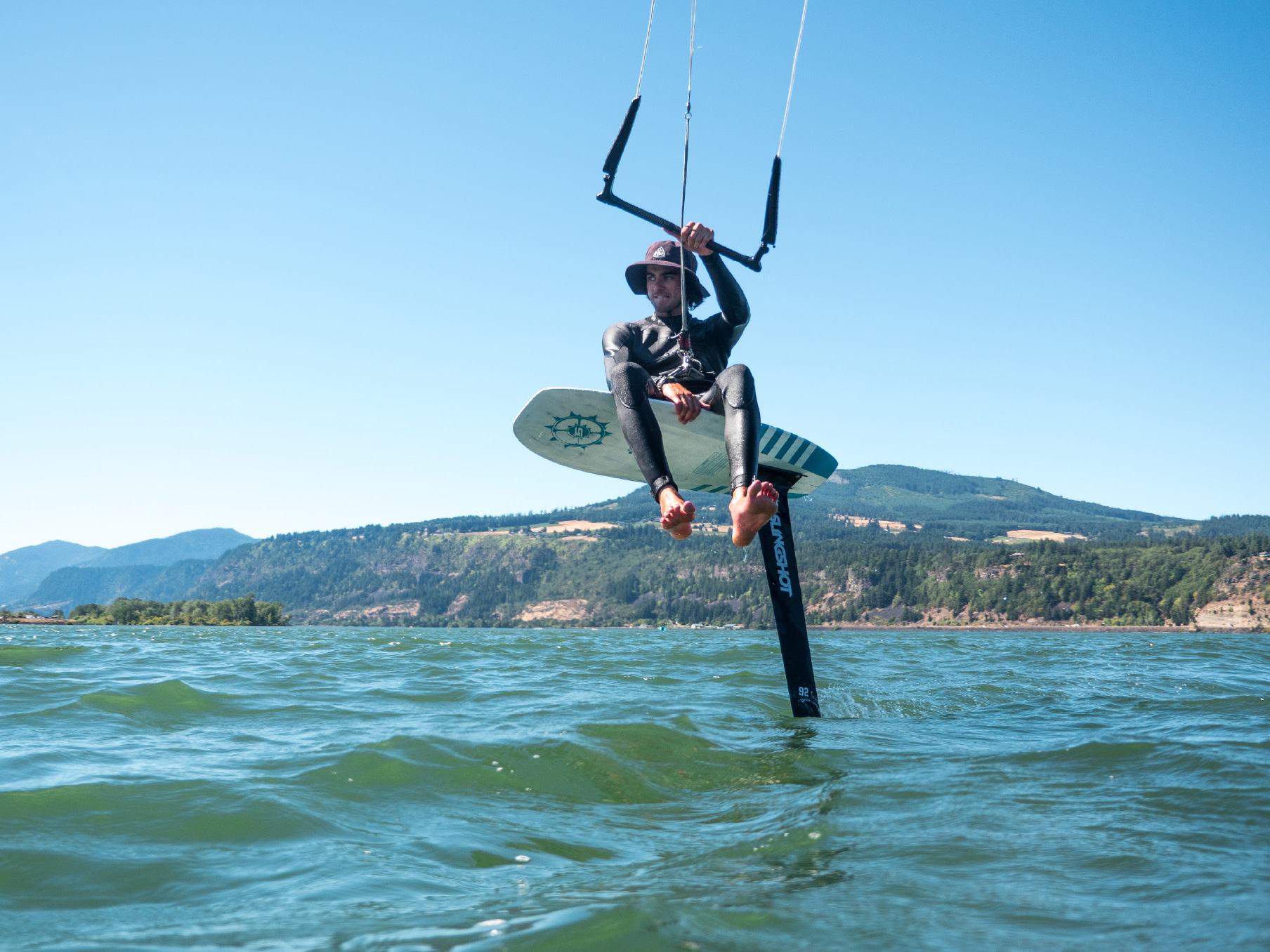
If Fred Hope didn’t invent sit-down foilboarding he certainly perfected it with insane balance and casual style. // Photo Kaden Sponhauer
HOW DID YOU TRANSITION FROM AN OBSESSION WITH STRAPLESS SURFBOARDS TO THE EARLY MAKINGS OF A FOIL PRODIGY?
I don’t think I ever really decided to pursue foilboarding; it was mostly about choosing the right equipment for the conditions. Although I split my time between strapless surfboards and foilboarding, I think relative to other people, I excelled at foilboarding and started putting more time into it just to get the most days on the water. During my first season foilboarding, I came back that summer to Hood River and got some gear from LP Foils, a custom foil house started by Peter Lederer in the Gorge. I spent a lot of time on the water and started experimenting with strapped jumping. At some point, Tony Logosz from Slingshot gave me a red and grey deck to check out and I decided to try it without straps. That was the first time I rode a foilboard strapless and at first, I wasn’t really hooked, partly because it was hard and I was still really into jumping. But, at some point, I got bored with jumping and at about that same time I became interested in more technical riding. I started thinking about how to use the kite differently and that’s where footstraps became a problem. When you use straps, you are locked into one place on the board, but by going strapless you can dial in your stance for different speeds and angles to achieve the greatest efficiency. As soon as I took the straps off, the board became a stage to dance around on without the risk of tripping up.
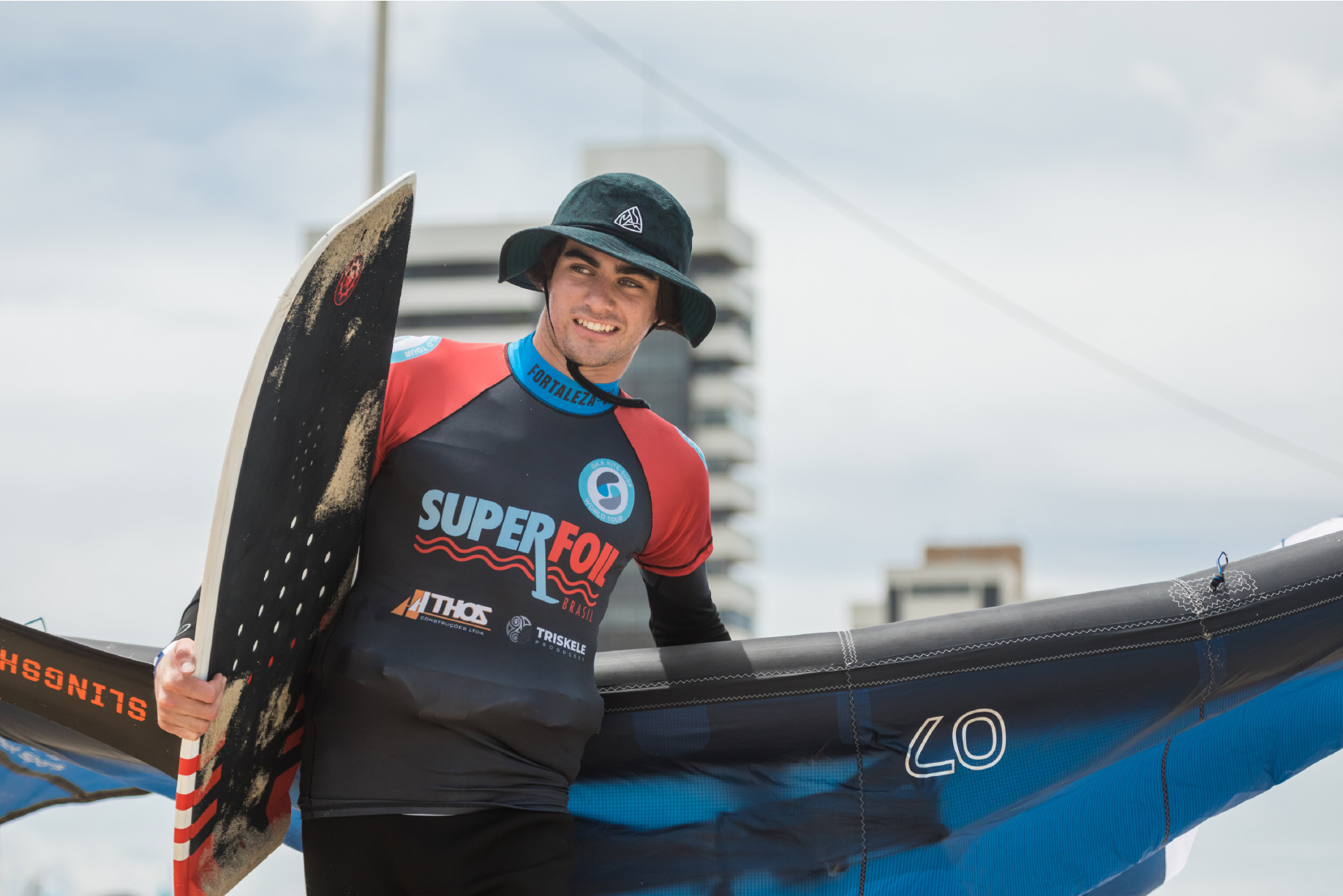
With his trademark bucket hat, wiry limbs and freakishly talented knack for riding foils, when Fred is on the water he can be spotted from a mile away. // Photo Svetlana Romantsova
EARLY ON YOU BEGAN TO TURN HEADS AT THE BEACH. WHAT WERE SOME OF THE INITIAL INNOVATIONS YOU BROUGHT TO FOILING?
I began to start thinking about experimenting with stuff that you couldn’t do on any other kind of board. Jumping and backrolls were possible on a surfboard, so the search began for tricks that were unique to the foilboard. I started experimenting with the kite upwind of me, and I remember one of my friends asking me, “What is the plan with that?” At that point, I had no idea. I just wanted to see how far upwind of me I could get the kite.

At first, there was no plan to get the kite around me””I was just messing with the wind. Eventually, I would go so far that the kite would fall out of the sky, land in the water, and I would still be foiling. I began pumping when the kite would fall on the water, getting closer and closer to going all the way around the kite. Then I tried shorter, 10-meter lines on a homemade bar and that instantly changed the equation. I could foil around the kite while keeping the lines tensioned, and that became the around the world trick. When I transitioned back to regular 20-meter lines, I couldn’t maintain the tension, but I could position the kite just perfectly so that it would glide downwind while I went around the world. These became the two forms of the around the world that I have today.
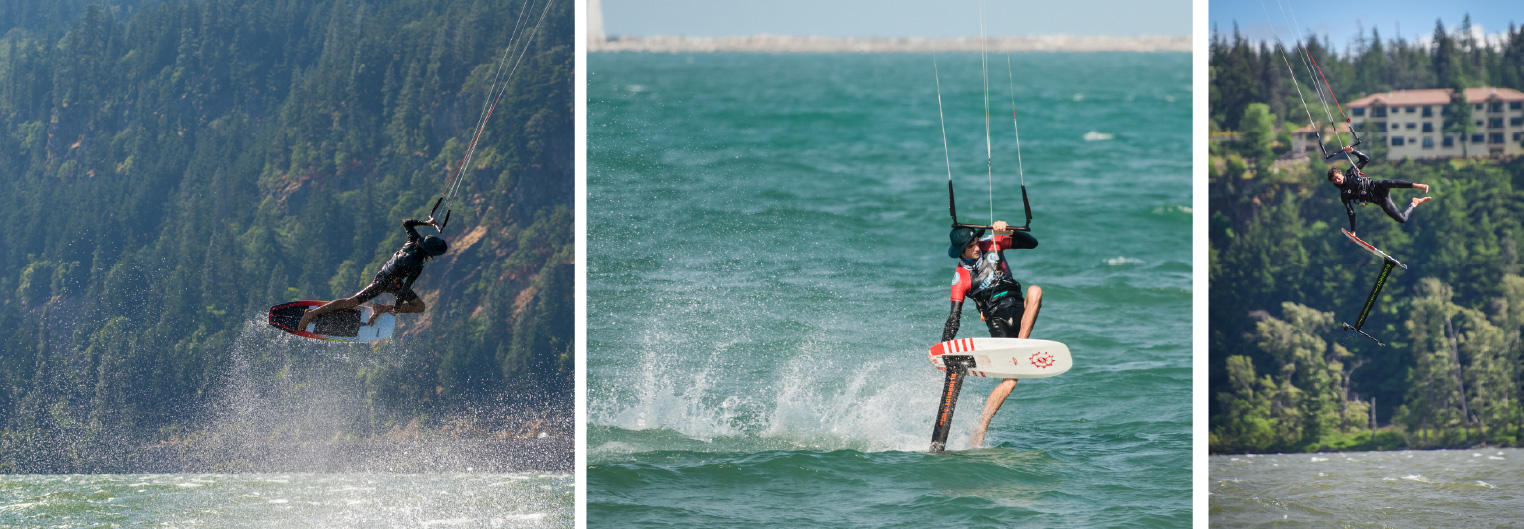
LEFT: Famous for his pro-level kitefoiling, Fred is also no slouch when it comes to strapless freestyle. // Photo Bob Stawicki MIDDLE: Fred’s style integrates high speeds with razor-precise board control through aggressive maneuvers that are both smooth yet extreme at the same time. // Photo Svetlana Romantsova RIGHT: Early in his progression, Fred chose to stop using straps and has paved the way for strapless foil airs through the use of grabs and technique. // Photo Adam Lapierre
PEOPLE END UP MESMERIZED WHEN THEY WATCH YOU FROM THE BEACH. YOUR RIDING SEEMS TO BE FAST, INCREDIBLY PRECISE AND TENUOUS. WHAT ALLOWS YOU TO PUSH THE LIMITS OF FINESSE AND SETS YOUR STYLE APART?
I’ve always been focused on efficiency””it’s been a big thing growing up. Maybe it sounds crazy, but I’ve thought about how systems are balanced, how things can be super connected and trying not to waste power. Perhaps it’s tied to environmentalism, or maybe it’s a fundamental principle of wind-based sports. When you’re propelled by nature, you’re really trying not to waste energy, and that becomes more apparent in light wind foilboarding. For instance, when you’re transferring through a foil tack, if you position and tune the kite just right and keep your board and weight working together, you can come out of the tack going faster. If you’re really attentive, you can use the lift of the foil and your body’s weight to propel you through the move, but this requires that everything in the equation is connected.

Caught on camera with the 633 freeride foil, Fred typically defaults to the Phantasm 657 for his high octane style of riding. // Photo Kaden Sponhauer
Part of it is also knowing exactly what the wind is doing, keeping an eye on the water, watching gusts move across the water as well as constantly tuning your body position and the trim of the bar. The consistency in my riding comes from hours on the foil. I don’t think of myself as a natural athlete””I can’t do a frontflip or a backflip on a trampoline””but because I’ve spent a ton of time on a foil, I can do things that are equally technical. Once I went to college, I began only kiting during breaks or sometimes on the weekends. I wasn’t expecting the positive impact this would have on my foiling. I’d go on these kiting breaks and figure out tricks I’d never thought of, likely due to the time away from the sport. I’d also spend a decent amount of time sitting in class thinking about new tricks to try.
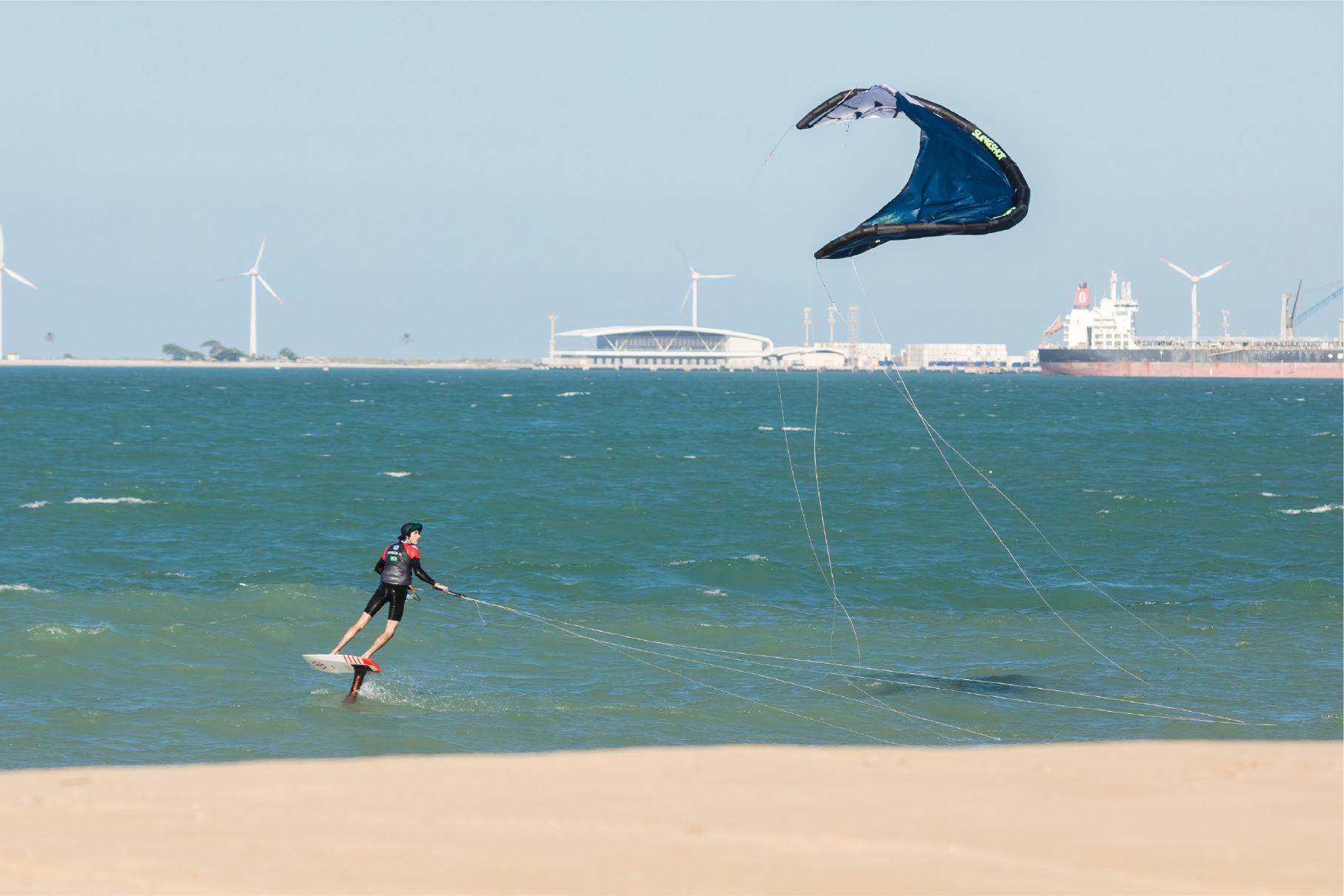
Fred slacks his lines and carves through his around the world trick at the SuperFoil event in Brazil where he took the podium. // Photo Svetlana Romantsova
THIS YEAR THE GKA SHOWCASED A NEW FREESTYLE FOILBOARDING EVENT IN BRAZIL AND YOU TOOK HOME THE PODIUM. WHAT’S THE STORY ON FOIL COMPETITION?
I first got the invite to the SuperFoil event in September, and I shrugged it off because I didn’t know who would go; I was rehabbing an injury from the summer and I would be in the thick of school. I hurt my hip landing a backroll on my surfboard, and the labrum in my hip’s ball and socket needed some downtime. I had been taking it easy for most of the summer, doing tons of wingfoiling instruction and the occasional photoshoot. When I was back at college, I got a text from Slingshot’s brand manager, Alex Fox, asking me if I was going to Brazil, and at that point, I still wasn’t sure. I finished my midterms a week before the foil contest, and it looked like it was shaping up to be a legitimate event. I was also a bit curious as to what the new format would look like and wanted to see if I could influence the direction of where competition freestyle foilboarding would go. Since I needed a break, I got a last-minute ticket and headed to Brazil, even though at that point I hadn’t kited in a couple of months.
Knowing that there are two very different variations of freestyle foilboarding, one being strapped big air tricks and the other being my style, which focuses on unstrapped technical freeride tricks and smaller airs with board grabs, I wasn’t sure how the judging would be calibrated. I knew my biggest competition would be Charles Brodell, a French rider who does big strapped-in airs, and throughout the qualifying heats, was getting higher scores for his tricks. What we were doing was completely opposite, not that his riding isn’t cool. If I was someone that didn’t know every detail of kiting, and I was watching Charles, I’d be super impressed with the height of his jumps, taking the board off, doing more spins and landing fast. At one point in a semi-final, I was up against Maxime Chabloz, who landed a 20-foot high dangle-pass; I thought I was going to get eliminated right there, yet I ended up taking that heat.

LEFT: Going head to head with strapped riders, Fred knew he needed the widest range of strapless tricks and spent the time in-between heats upwind inventing new moves. // Photo Svetlana Romantsova RIGHT: Carving a hard line with the cityscape of Fortaleza in the background, Fred focused on high-speed maneuvers and extra intensity that helped stack the points in his favor. // Photo Svetlana Romantsova
Having not kited in quite a while and knowing that my style of strapless freeride foilboarding was up against strapped freestyle, I was going to need more diversity in my tricks. When other riders went back to the beach to rest between heats, I would foil upwind and work on new tricks. I started landing new jumps where I’d launch toeside, grab the rail of the board through a down loop and then land the trick sitting down. Getting the foil to reengage on landings and immediately create lift before riding away is hard, especially when you’re sitting down. But it certainly shows you that we haven’t tapped the true potential of foiling””if I’m able to go upwind and come up with new tricks during a contest””then it confirms that the future of foilboarding is wide open.
After winning that heat against Maxime, it opened up the questions about scoring and how the judges would be rating our two very different styles of riding. There was this concern that a scoring system that only rewards technical handlepasses would not appeal to the typical foilboarder who identifies with carving, tacking and strapless riding. Clearly, there are going to be advocates for the big air strapped style of riding, but the goal with the SuperFoil contest was to create an event that would engage the growing number of foilboarding consumers and ensure it was relatable to the market.
I ended up in the final going head to head with Charles Brodel, and it was probably the most fun heat I have ever had. We were screaming around each other in close proximity, demonstrating the two different styles of foilboarding, both at very high levels. At the end of that heat, I half expected the judges to call a tie because we were both doing such incredible things, but I ended up getting higher points and walking away with the trophy. In the conversations that followed, the judges were allocating points to moves that were foil specific, and the stuff that you could do with twin tips just didn’t score quite as high. Sure, you could land a handlepass in competition, but when pitted against the flow and efficiency-inspired freeride moves I was focusing on and executing solidly, it was enough to connect all the dots for the win.
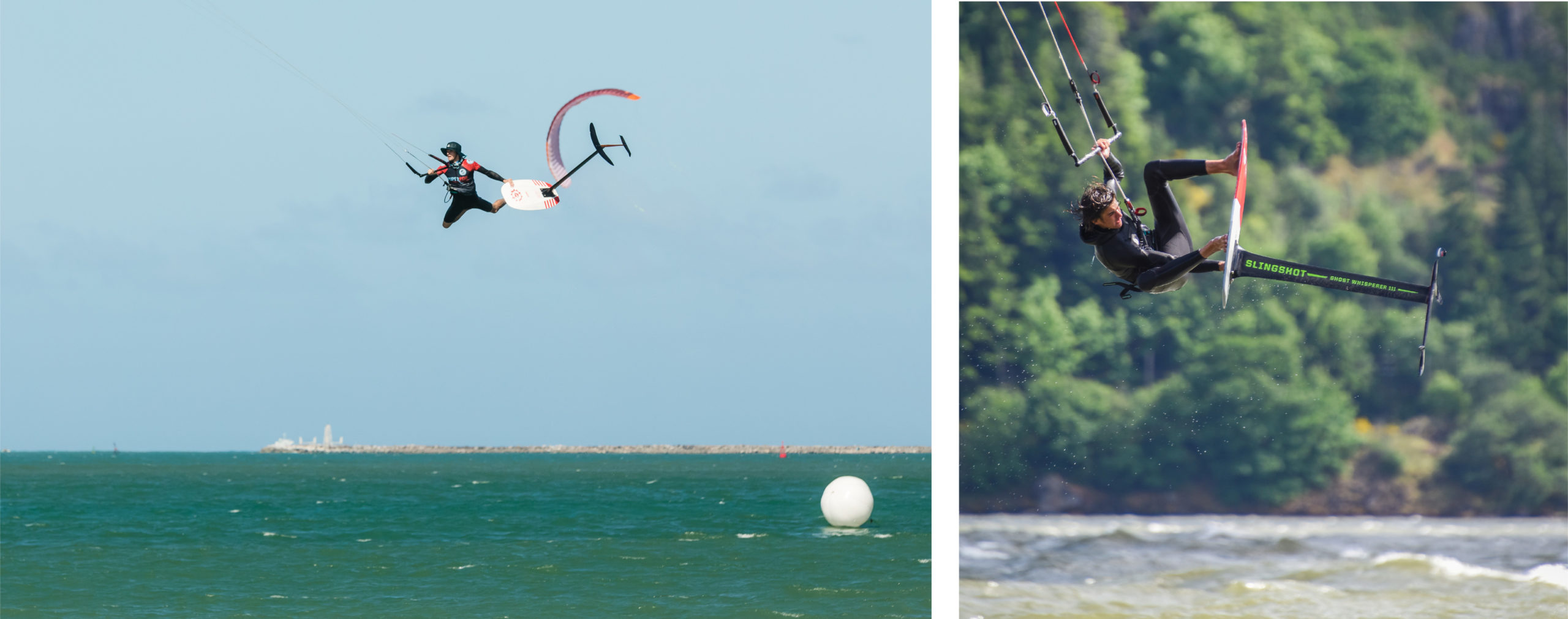
LEFT: The brave combination of a powered kiteloop and strapless air results in a high-altitude free-for-all. // Photo Svetlana Romantsova RIGHT: According to Fred, he never chose foilkiting over strapless freestyle, but having excelled in the former, it has staked him a reputation. // Photo Adam Lapierre
JUST TO BACK UP FOR A SECOND, WHAT IS YOUR SECRET TO LANDING BIG STRAPLESS AIRS?
It’s really hard to get the wing to reengage when you’re landing strapless, but it’s all about getting the perfect angle. I try to get the fuselage to enter the water at about 45° down, and as soon as you feel it engage, you add back foot pressure. Freeride foils with lower aspect wings aren’t quite as extreme because they have more surface area. Essentially, you are entering the water at an angle that will clear the air pockets that attach to the top/trailing edge of the wing. It’s all about Bernoulli’s principle; you get your lift from the water on top of the foil flowing faster than the bottom. Although I’m studying marine biology, I had to take some physics prerequisites and that has put some of the stuff I’m trying to do on a foil into perspective.

Photo Svetlana Romantsova
FRESH OFF A WIN IN FOILBOARDING’S FIRST LEGITIMATE WORLD CHAMPIONSHIP AND WITH A BIT MORE COLLEGE WORK AHEAD OF YOU, WHAT’S THE NEXT STEP?
I have about two years left of college left and with the pandemic, I’m not in a hurry to cut that short. I’m not entirely sure what’s next. I’ve always thought of kiting as a hobby that gets me around, rather than a job, but I would like to do some pro-coaching trips for foilers that are looking to master basic and more advanced foiling skills. With my bachelor’s in Marine Biology, I’d normally go straight into research, but I also feel like it would be a missed opportunity to not use my kiting skills to see more of the world. I’ll get back to you on that question in the next couple of years!

This article first appeared in Tkb’s Winter 2022 issue, Vol. 17, No. 3 Want more like this? Subscribe to The Kiteboarder Magazine.

